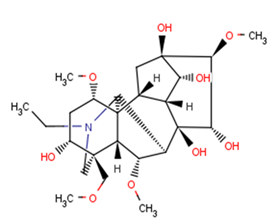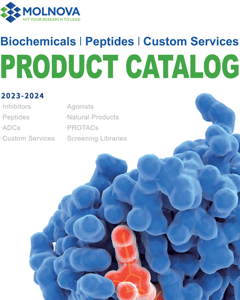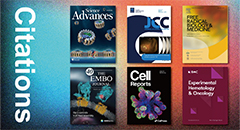
Aconine
CAS No. 509-20-6
Aconine( Jesaconine )
Catalog No. M18683 CAS No. 509-20-6
Aconine possesses gastric anaesthetic props.
Purity : >98% (HPLC)
 COA
COA
 Datasheet
Datasheet
 HNMR
HNMR
 HPLC
HPLC
 MSDS
MSDS
 Handing Instructions
Handing Instructions
| Size | Price / USD | Stock | Quantity |
| 5MG | 102 | In Stock |


|
| 10MG | 170 | In Stock |


|
| 25MG | 287 | In Stock |


|
| 50MG | 428 | In Stock |


|
| 100MG | Get Quote | In Stock |


|
| 200MG | Get Quote | In Stock |


|
| 500MG | Get Quote | In Stock |


|
| 1G | Get Quote | In Stock |


|
Biological Information
-
Product NameAconine
-
NoteResearch use only, not for human use.
-
Brief DescriptionAconine possesses gastric anaesthetic props.
-
DescriptionAconine is the febrifuge. Aconine possesses gastric anaesthetic props.
-
In VitroTreatment with Aconine significantly inhibits the RANKL-induced transcriptional activity of NF-κB in a dose-dependent manner. Aconine inhibits RANKL-induced osteoclast differentiation in RAW264.7 cells by suppressing the activation of NF-κB and NFATc1 and the expression of the cell-cell fusion molecule DC-STAMP. Aconine (0.125, 0.25 μM) does not affect the viability of RAW264.7 cells, but dose-dependently inhibits RANKL-induced osteoclast formation and bone resorptive activity. Aconine dose-dependently inhibits the RANKL-induced activation of NF-κB and NFATc1 in RAW264.7 cells, and subsequently reduces the expression of osteoclast-specific genes (c-Src, β3-Integrin, cathepsin K and MMP-9) and the expression of dendritic cell-specific transmembrane protein (DC-STAMP), which plays an important role in cell-cell fusion.
-
In Vivo——
-
SynonymsJesaconine
-
PathwayOthers
-
TargetOther Targets
-
RecptorOthers
-
Research AreaOthers-Field
-
Indication——
Chemical Information
-
CAS Number509-20-6
-
Formula Weight499.6
-
Molecular FormulaC25H41NO9
-
Purity>98% (HPLC)
-
SolubilityDMSO : ≥ 125 mg/mL; 250.21 mM
-
SMILESCCN1CC2(C(CC(C34C2C(C(C31)C5(C6C4CC(C6O)(C(C5O)OC)O)O)OC)OC)O)COC
-
Chemical Name——
Shipping & Storage Information
-
Storage(-20℃)
-
ShippingWith Ice Pack
-
Stability≥ 2 years
Reference
molnova catalog



related products
-
5-TAMRA chloride(918...
5-TAMRA can produce bright, pH insensitive orange fluorescence (Ex/ Em= 546 / 579nm), and has good photostability
-
Sanggenol L
Sanggenol L shows higher cytotoxicity against human oral tumor cell lines (HSC-2 and HSG) than against normal human gingival fibroblasts (HGF), it induces apoptosis via caspase activation and inhibition of NF-κB/IκBα± phosphorylation as a potent chemotherapeutic agent for ovarian cancers.
-
Chrysoobtusin
Chrysoobtusin belongs to the class of organic compounds known as hydroxyanthraquinones.



 Cart
Cart
 sales@molnova.com
sales@molnova.com


